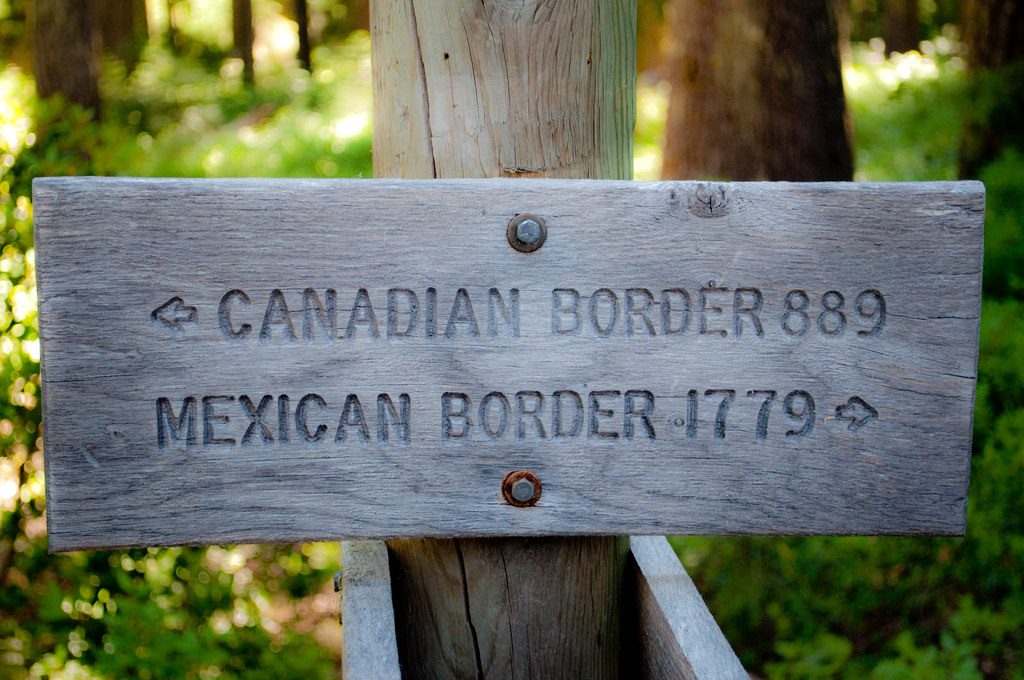Activities
- Search Google Images for the Canada-US and Mexico-US borders. Which images represent conventional understandings of these borders, and why? Which challenge those assumptions?
- Borders “figure as occasions to imagine, often aggressively, fixed and unrelenting standards of citizenship and belonging” (Castronovo 196). Devise a definition of citizenship, then read Thomas King’s short story “Borders.” Why do the border guards refuse to accept the mother’s Blackfoot citizenship? What is at stake in their questions and her answer?
- Watch “Underground Railroad,” a Heritage Minute produced by Historica Canada (see Chariandy 544-45). How does this video representation compare with crossings in Black Canadian border texts?
Works Cited
-

Sign on the Pacific Crest Trail, Oregon. Carissa Rogers, 2010. CC BY 2.0, via Flickr.
Castronovo, Russ. “Compromised Narratives along the Border: The Mason-Dixon Line, Resistance, and Hegemony.” Border Theory: The Limits of Cultural Politics. Ed. Scott Michaelsen and David E. Johnson. Minneapolis: U of Minnesota P, 1997. 195-220.
- Chariandy, David. “Black Canadian Literature: Fieldwork and ‘Post-Race.’” The Oxford Handbook of Canadian Literature. Ed. Cynthia Sugars. New York: Oxford UP, 2016. 539-63. Print.
- Historica Canada. “Underground Railroad.” Heritage Minutes. 1991. Video.
- King, Thomas. “Borders.” One Good Story, That One. Toronto: HarperPerennial, 1993. 131-45. Print.
Additional Resources
Other Border Texts
- Briesmaster, Allan, and Steven Michael Berzensky, ed. Crossing Lines: Poets Who Came to Canada in the Vietnam War Era. Hamilton: Seraphim, 2008. Print.
- King, Thomas. Truth & Bright Water. Toronto: HarperFlamingo, 1999. Print.
- Longworth, David, et al. USNA: The United States of North America. Vancouver: USNA, 2012. Print.
- McGill, Robert. Once We Had a Country. Toronto: Knopf, 2013. Print.
- McLeod, Joan. Amigo’s Blue Guitar. Winnipeg: Blizzard, 1990. Print.
- Rebar, Kelly. Bordertown Café. 1987. Vancouver: Talonbooks, 2003. Print.
- Shields, Carol. Larry’s Party. 1997. Toronto: Random House, 1998. Print.
- —. The Stone Diaries. Toronto: Vintage, 2002. Print.
- Vanderhaeghe, Guy. The Last Crossing. Toronto: McClelland & Stewart, 2002. Print.
- Verdecchia, Guillermo. Fronteras Americanas/American Borders. 2nd ed. Vancouver: Talonbooks, 2012. Print.
Scholarly Studies
- Berland, Jody. “Writing on the Border.” Canadian Cultural Studies: A Reader. Ed. Sourayan Mookerjea, Imre Szeman, and Gail Faurschou. Durham: Duke UP, 2009. 472-87. Print.
- Clarke Gray, Brenna. “Border Studies in the Gutter: Canadian Comics and Structural Borders.” Canadian Literature 228/229 (2016): 170-187. Print.
- Davidson, Arnold E., Priscilla L. Walton, and Jennifer Andrews. Border Crossings: Thomas King’s Cultural Inversions. Toronto: U of Toronto P, 2003. Print.
- Kang, Nancy. “‘As if I had entered a Paradise’: Fugitive Slave Narratives and Cross-Border Literary History.” African American Review 3 (2005): 431-57. Print.
- Manzanas-Calvo, Ana María. “Hosting the Crosser: Janette Turner Hospital’s Borderline.” Canadian Literature 233 (2017): 71-87. Print.
- Roberts, Gillian. Discrepant Parallels: Cultural Implications of the Canada-US Border. Montreal: McGill-Queen’s UP, 2015. Print.
- —. “Sameness and Difference: Border Crossings in The Stone Diaries and Larry’s Party.” Canadian Literature 191 (2006): 86-102. Print.
- Sadowski-Smith, Claudia. Border Fictions: Globalization, Empire, and Writing at the Boundaries of the United States. Charlottesville: U of Virginia P, 2008. Print.
- Siemerling, Winfried, and Sarah Phillips Casteel, eds. Canada and Its Americas: Transnational Navigations. Montreal: McGill-Queen’s UP, 2010. Print.








 ©
©